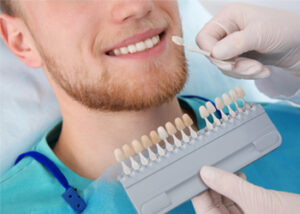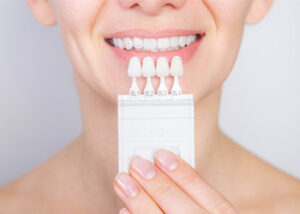Everyone deserves a smile that they are happy and confident with. This is why many patients resort to a smile makeover with cosmetic dentistry. And among the popular treatments are porcelain veneers.
One of the most common questions we are asked is do porcelain veneers stain? Read along to find out the answer and how you can maintain the beauty of your veneers.
So, what are veneers?
Veneers are a cosmetic dentistry treatment that uses wafer-thin sheets of porcelain material. They provide a quick fix to minor dental flaws involving the tooth’s size, shape, length, colour and position. Generally, veneers are used for the treatment of teeth that are:
- Misshapen
- Chipped
- Discoloured
- Gapped or crowded
 When placed on the front teeth, veneers create a more proportionate, vibrant, and confident smile.
When placed on the front teeth, veneers create a more proportionate, vibrant, and confident smile.
Generally, there are two types of veneers – composite and porcelain. If you’re looking for a durable restoration with a more natural finish, porcelain veneers are your best bet.
Porcelain is beautifully translucent, which mimics the light-reflecting property of natural teeth.
So, with porcelain veneers, you get a more lifelike and beautiful smile.
So, do porcelain veneers stain? – The science behind porcelain veneers
The good thing about porcelain veneers is that they are highly stain-resistant. They are made with glass-ceramic and are coated with a protective glaze to obtain a smooth surface. So, high-staining food and drinks are not able to penetrate through.
This is unlike the natural tooth, which is porous. The enamel surface has micro-openings that readily absorb the stain. So, your teeth can easily discolour with the regular consumption of dark-coloured drinks such as coffee, tea, and wine.
Because of this, porcelain veneers are an excellent investment when it comes to cosmetic dentistry treatments. The process involves a relatively painless and less invasive treatment that produces impressive long-term results.
Is there anything that can cause veneers to appear dull?
Despite porcelain veneers being highly resistant to staining, there are some ways in which they can appear stained. These are problems that are not directly related to the composition of the veneers but can affect how they look.
If your veneers are not as white as they used to be, here are some of the possible reasons:
- Temporary staining – This may be due to surface staining. However, this should be removed with a gel-based formula toothpaste. As a top tip, avoid whitening toothpaste because it can contain harsh abrasives and the veneer won’t respond to whitening agents anyway.
- Plaque retention – An accumulation of plaque can cause a yellowish build-up to form on the teeth surfaces or along the gum line. This “stain” can look unsightly and will need professional dental cleaning for an instant whitening effect.
- Gum recession – as you age, gums may naturally recede. This will show areas previously not visible and not covered by veneers. If this happens, the white cement that bonds your veneers to your teeth may show and appear discoloured.
- Damage to natural teeth – to maintain the tip-top condition of your veneers, you also have to take care of your natural teeth. Any damage or decay on the tooth under the veneer may reflect through onto your porcelain veneers.
- Darker natural teeth – discolouration of the natural teeth is also typical with age. Because your veneers remain one colour throughout their life, they will stand out among the natural teeth surrounding them, especially if the real teeth have significant staining.
If you’re concerned about your porcelain veneers seemingly looking duller, talk to our cosmetic dentistry team at Beyond 32 Dental. They can check to see if there is an underlying problem that needs addressing and provide treatment solutions for the general health of your veneers.
Taking Care of Your Porcelain Veneers
Now that we’ve answered the question, “do porcelain veneers stain?” the next thing to learn is how to maintain their pristine condition. Like your natural teeth, porcelain veneers need the same hygiene care to maintain their beauty and function.
Here are some tips for veneer up-keep and maintenance:
- Learn the proper brushing technique
Make sure you brush your teeth regularly with a soft-bristled toothbrush and gentle toothpaste. These are designed for use on porcelain veneers. Other products may be too harsh and abrasive, affecting your gums’ health and the condition of your veneers.
- Floss your teeth
Underneath your porcelain veneers are still your natural teeth. If exposed to bacteria, they will decay and discolour to shorten the life of your veneers. Avoid the build-up of bacteria that may start tooth damage by flossing the in-betweens of your teeth.

- Avoid smoking
While tobacco will not directly stain your veneers, it will cause your underlying teeth to be yellow and the gums to appear darker. This can lead to patchy and dull discolourations on your smile. Tobacco will also affect the bonding of your veneers to your teeth, so you may need to replace them sooner.
- Visit your dentist for a routine hygiene appointment
The health of tooth veneers is easily compromised without proper hygiene care. So, visit your dentist for regular check-ups and professional teeth cleaning. With excellent oral health, you can prevent dental issues and maximise the longevity of your veneers to keep your smile looking radiant.
Are you interested in porcelain veneers?
Whether you need a regular dental check-up or cosmetic dentistry treatments such as porcelain veneers, our team at Beyond 32 Dental is here to help. Call us at (02) 8806 3799 to schedule a consultation where you can find out more information about cosmetic veneers such as do porcelain veneers stain? And to see whether you’re a good candidate.
References
WebMD – Dental Veneers
https://www.webmd.com/oral-health/guide/veneers
PubMed – Application of porcelain veneers
https://pubmed.ncbi.nlm.nih.gov/8222939/
PubMed – Characterization of the porosity of human dental enamel and shear bond strength in vitro after variable etch times: initial findings using the BET method
https://pubmed.ncbi.nlm.nih.gov/21341996/
WebMD – Plaque and Your Teeth
https://www.webmd.com/oral-health/guide/plaque-and-your-teeth
MedlinePlus – Aging changes in teeth and gums
https://medlineplus.gov/ency/patientinstructions/000951.htm#:~:text=Receding%20gums%20are%20common%20in,can%20cause%20gums%20to%20recede.
WebMD – Choosing a Toothbrush: The Pros and Cons of Electric and Disposable
https://www.webmd.com/oral-health/guide/choosing-a-toothbrush-the-pros-and-cons-of-electric-and-disposable#:~:text=For%20the%20vast%20majority%20of,surface%2C%20and%20protective%20tooth%20enamel.
CDC – Gum (Periodontal) Disease
https://www.cdc.gov/tobacco/campaign/tips/diseases/periodontal-gum-disease.html









